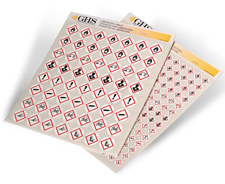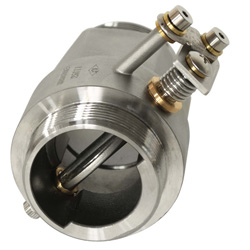| The Home page of ILPI's Safety Data Sheet (SDS) Resource, the leader in SDS information since 1995! | |
| The history and philosophy behind this resource. | |
| A curated collection of books and reference materials concerning Safety Data Sheets and closely related topics. | |
| Paste your plain text SDS into the SDS-Demystifier, and it will be converted into a hypertext-enriched document with links to detailed explanations of each key term. | |
| An extensive list of frequently asked questions about Safety Data Sheets including regulations, content, compliance, and more. | |
| A humorous take on Safety Data Sheet jargon. Fill in the blanks on our entry form to generate a personalized Unsafety Data Sheet to share with your coworkers. | |
| Since 1995, we've maintained this massive curated list of the best places to find Safety Data Sheets on the Internet. | |
| You are here! Way more than a glossary, this hypertext-enhanced resource covers hundreds of SDS-related terms and expert knowledge. Each entry includes both the SDS relevance and links to additional authoritative resources. | |
| Archived results of Safety Data Sheet related polls taken by some of our millions of site visitors | |
| The OSHA regulations behind SDS regulations, including the inspection guidelines and over 400 official interpretations letters under the Hazard Communication Standard | |
| Commercial suppliers of SDS authoring and management software as well as cloud compliance services. | |
| Commercial companies that will create SDS's for your specific needs as well as SDS translation companies. |

Safety signs, banners, and scoreboards? Get yours at Safety Emporium!
Definition

Get your GHS-compliant labels and signs from Safety Emporium.
On Safety Data Sheets: An evaporation rate is the rate at which a material will vaporize (evaporate, change from liquid to vapor) compared to the rate of vaporization of a specific known material. This quantity is a ratio, therefore it is unitless.
General usage: The mass of material that evaporates from a surface per unit time (examples: 3 grams per square meter per hour, 1 inch per acre per month).
Additional Info
Evaporation rates generally have an inverse relationship to boiling points; i.e. the higher the boiling point, the lower the rate of evaporation. However, two substances with the same boiling point can have significantly different evaporation rates.
The general reference material for evaporation rates is n-butyl acetate (commonly abbreviated BuAc) which has the chemical structure shown below. Whenever a relative evaporation rate is given, the reference material must be stated.

The relative evaporation rate of butyl acetate is 1.0. Other materials are then classified as:
(BuAc = 1.0)
Isobutyl Alcohol = 0.6
Water = 0.3
Mineral Spirits = 0.1
We are not aware of a specific number for the absolute evaporation rate (i.e. in mass/time units) of butyl acetate. Presumably, such a number would depend on myriad variables such as temperature, atmospheric pressure, humidity, air flow, viscosity etc. The ASTM developed a standard test method, D3539-87(2004) Standard Test Methods for Evaporation Rates of Volatile Liquids by Shell Thin-Film Evaporometer, but it was withdrawn in 2015 without public explanation.
In the absence of evaporation rate data, you can roughly assess the volatility using the vapor pressure of the material. A number of models are available in the scientific literature; see Further Reading below for some examples.
SDS Relevance
If applicable and known, a substance's evaporation rate will appear in Section 9 (physical and chemical properties) of the Safety Data Sheet.
Evaporation rate can be useful in evaluating the health and fire hazards of a material. For example, a substance with a high evaporation rate will readily form a vapor which could be inhaled or explode.

Vent your flammable storage safety cabinets safely with Safe-T-Vent thermally-actuated dampers from Safety Emporium.
Further Reading
- Evaporation Kinetics of Liquid Mixtures and Safe Handling in ACS Chem. Health Saf. 2023 reports a simple and inexpensive method for the measurement of the evaporation rate of liquid mixtures and further estimation of the flash point.
- Predicting Evaporation Rates from Pools (not the swimming kind!) from Chemical Engineering Transactions, 2016, 48, pp 49-54.
- Predicting Evaporation Rates and Times for Spills of Chemical Mixtures from Ann. Occup. Hyg., 2001, 48(6), pp 437-445.
- Estimating Rates of Spreading and Evaporation of Volatile Liquids from CEP Magazine, January 2005; bootleg copy. Official download here.
- Preview of Evaporation of Pure Liquids from Open Surfaces from Modelling of Environmental Chemical Exposure and Risk. NATO ASI Series (Series IV: Earth and Environmental Series), 2001, vol 2.
- Modelling spreading, vaporisation and dissolution of multi-component pools, a 2013 PhD thesis by Maria Isabel Fernandez of University College London.
- Review of Glycol Ether and Glycol Ether Ester Solvents Used in the Coating Industry. This 1984 article touches on the concept of evaporation rate and how it has been used in the coatings industry.
- Additional suggestions welcome. We are unaware of any tabular source of evaporation rate data. If you need to find an evaporation rate, consult the SDS for the material.
- Coatings Clinic: Solvent Properties at the American Coatings Association discusses how relative rates of weight loss are used rather than absolute values.
See also: alcohol, boiling point, vapor pressure, volatility.